

Didask methodology: feedback from the AMA Network
The AMA Network uses the Didask platform and methodology to design and design its eLearning training modules on well-treatment or autism.
A key player in personal services, AMA Network (for Supporting and Maintaining Autonomy) now includes 75 micro-crèches and 80 personal service agencies and 2 Babadines (alternative to the retirement home). The network thus supports young children and the elderly every day, with the desire to include the most vulnerable groups or those suffering from disorders (autism, Alzheimer's, addictions, etc.) in their care arrangements. As a result, there are significant training challenges for the teams, who have been using Didask's methodology for several weeks to structure their courses and integrate relevant practical cases into their training, on topics such as support postures in well-treatment or the management of autism.
Idenne Bekouet (IB), Training Manager, and Corentin Le Marec (CLM) Early Childhood Consultant, tell us about their missions and the impact of the Didask method on their pedagogical work.
With Didask our objective is to provide resources and reference points to manage difficult situations.
When supporting vulnerable groups, staff training takes on a particularly crucial dimension. How was Réseau AMA organized?
CLM: Our training actions are delivered via our online school, AMA Campus, in which we develop educational content for the staff of agencies, nurseries, and Babadines*. Audiences mainly life assistants, educators of young children or childcare assistants.
Through the use of the Didask methodology, our objective is to strengthen their skills in a whole range of areas, such as for example or in the care of autistic children. We also develop content inspired by Montessori pedagogy for elderly people with Alzheimer's disease, sign language training for babies etc. We are also working on heavier content, for graduates, such as the AVF (Family Life Assistant) and the CAP Early Childhood. We create preparatory modules for obtaining these degrees.
IB: I would add that SAP (Personal Services) is one of the three most accidental sectors of activity, even ahead of construction, and we are obliged to train our teams. We have no choice, it is a decision of the State, but we want to do it as efficiently as possible!
CLM: With Didask, our objective is, to strengthen the skills of our learners but also to equip them, to give them the means and points of reference to manage difficult situations in a whole host of areas. For example, in the adoption of well-treated postures in all circumstances or in the appropriate care of autistic children.
What place does eLearning occupy in the middle of all your initiatives?
CLM: Essential, because we need to offer devices that are easily appropriated. Whether in human services or early childhood services, staff have very tight schedules. It's very hard to get them out of the agencies to send them for training. We wanted to create our e-learning platform to be able to focus our face-to-face training on activities with high educational added value, to facilitate the organization of training. Online times can be more easily divided in the evening, at noon...
How did you get to Didask?
CLM: We came to Didask because our idea was not just to sell hours online. And today we know that with theoretical content ingested in read-scrolling mode, our learners don't remember much at the end. This is where we were challenged by Didask's approach. Relying on cognitive psychology, on learning mechanisms, The trial and error, the valorization of error, of challenging intuitive knowledge even before being confronted with theoretical knowledge... all this spoke to us.
So you were looking for a solution that could easily be integrated into your existing tool ecosystem.
CLM: Yes and we worked on it with your educational engineers. We already had our platform, but on each theme, we wanted to start by challenging the intuitive knowledge of learners with Didask practical cases to push them to make mistakes, break their preconceived ideas and prejudices.
And in a second step, we confront them, with our own platform, with theoretical knowledge. They will have videos, interactions with other learners and they will be able to assess themselves.
Didask's methodology allows you to have an initial question on the topics covered. It allows you to sort out the educational objectives and to focus on the real changes that you want to see in the learner!
How has the Didask methodology changed the way you develop your training courses?
IB: Didask's methodology allows you to have an initial question on the topics covered. It allows you to sort out the educational objectives and to focus on the real changes that you want to see in the learner! In terms of behaviors, postures, attitudes during the provision of services.
The Didask method also changed the way we worked with other tools, in the sense that we usually started by working on theoretical content first.
Now we start by dividing our courses according to the Didask method, and we will then articulate the theoretical content and the face-to-face sessions around these Didask seeds. This is where it completely changes the way we work.
CLM: It also allows us to better focus on the highlights. Didask being limited in terms of volume, we are not going to make 500 seeds on a theme, so we must focus on the essential elements, those that we want to anchor.
Starting from each seed, which each present 5-6 situations, we will be able to articulate the rest of the theoretical knowledge, trying to enrich this knowledge.

Exactly, how did this work of identifying key concepts happen?
IB: Educational engineers supported us a lot on the first seeds, so that we could understand what are the relevant mistakes that our learners can make. And once we have identified where these errors came from, it allows us to create other activities with other tools, on training content that will be focused on these errors.
CLM: They trained us in the whole granularization process, which is not necessarily intuitive. The process for identifying relevant errors, disturbing contexts or distractors is not always natural, and their support has been very valuable and very effective. Today, Idenne is very advanced on the subject and she is now in a position to enter into this thinking mechanism.
With Didask, when you have raised the possible margin of error, when you really understand where people are wrong, and what people are doing “wrong”, you have a much easier time finding relevant theoretical content to guide them in the right direction.
Do you now feel autonomous for the future?
IB: Autonomous on the method yes, on the other hand I always appreciate being advised by your teams and I consult them regularly to get their opinion.
In fact, with Didask, when you have raised the possible margin of error, when you really understand where people are wrong, and what people are doing “wrong”, you have a much easier time finding relevant theoretical content to guide them in the right direction.
So I think Didask was super important on that. Knowing where people are wrong helps us to fill in the gaps, because otherwise we really start with theoretical input that does not necessarily satisfy everyone. It allows us to sort between knowledge that is useful and that which is not used directly in work situations.
Didask in a nutshell, what is it for you?
IB: I would simply say a good pedagogical approach! Learning through trial and error is not particularly new, but for me, for example, I have been in pedagogy for 3 years and a half and I had never thought of doing this. It had to be developed and implemented.
CLM: I would say that it is a pragmatic, contemporary and evolving training platform that lives with the times. Didask starts from the observation that today eLearning is essential, that the level of quality is not always high, but nevertheless remains convinced that eLearning can be trained well. The cognitive science, cognitive psychology gives us keys, and Didask is the result of this convergence of elements.
Make an appointment directly with our eLearning experts for a demo or simply more information.












